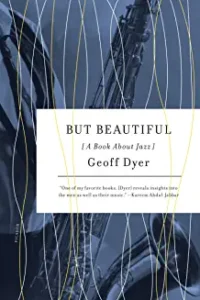But Beautiful: A Book About Jazz by Geoff Dyer 1996
Dyer, a Brit who is currently a visiting professor at USC, is one of my favorite non-fiction writers. A brilliant stylist with a seemingly infinite curiosity and deep background in literature, sports, music, etc, I have thoroughly enjoyed all of his work. This book, one of his earliest, was recommended by a new acquaintance during a dinner in Marin County last March, and I finally got around to reading it. Grateful for the tip, Malcolm.
‘But Beautiful’ is a treasure for the jazz aficionado, though most of the particulars went by me. The final chapter in the book entitled ‘Afterword: Tradition, Influence, and Innovation’ in which Dyer dives deeply into the current jazz scene in the late 1990’s drawing lines of influence and calling upon another favorite of mine, Harold Bloom to apply Bloom’s ‘Anxiety of Influence’ theories to jazz, was especially esoteric.
Much more accessible to me were the chapters in which Dyer channels individual artists. Lester Young, Bud Powell, Ben Webster, Thelonious Monk, Art Pepper, Charlie Mingus, and Chet Baker each have a chapter in which Dyer “presents the musicians not as they were but as they appear to me.” as he “projects back onto the moment of the music’s inception the act of my hearing it thirty years later.” Dyer is clear that he’s not quoting individuals but painting a picture of them from his experience. And what stories he tells about these incredibly talented but fatally flawed individuals—-alcohol, heroin, police beatings, prison time, malnutrition, mental breakdown, schizophrenia all make an appearance, and all contributed to the meteoric rise of these talents and their way-too-early deaths. The writing in these chapters is powerful and moving.
As an introduction to each of these chapters, Dyer imagines the conversation between Duke Ellington and Harry Carney who spent more than 40 years in Duke’s orchestra as they drive cross country for one-night, small town gigs. Ellington’s creative process is highlighted. As they drive through the night past freight trains, small towns, and gas stations listening to random music on the car radio, Ellington finds the germ of an idea for a new composition which he scrawls on random menus and other scraps of paper.
Much of this book was beyond me because, though I enjoy listening to jazz and even have some favorites (the pianist Bill Charlap and his trio are my faves), I’m not even an amateur expert. But I was swept along by Dyer’s prose, I’m confident that this book is an absolute must for the jazz lover. A list of sources and a discography which end the book will be a treasure trove for such a person. In a brief deeper dive into the subject matter in that final chapter, I picked out a random jazz musician’s name who Dyer briefly alluded to, a man named Henry Threadgill, and I Googled him. Turns out that he won the Pulitzer Prize in Music in 2016 for his album ‘In for a Penny, In for a Pound’. Clearly Dyer knows his stuff.
If you are deeply into jazz, read this. You will also enjoy it if you’re deeply into Dyer.



